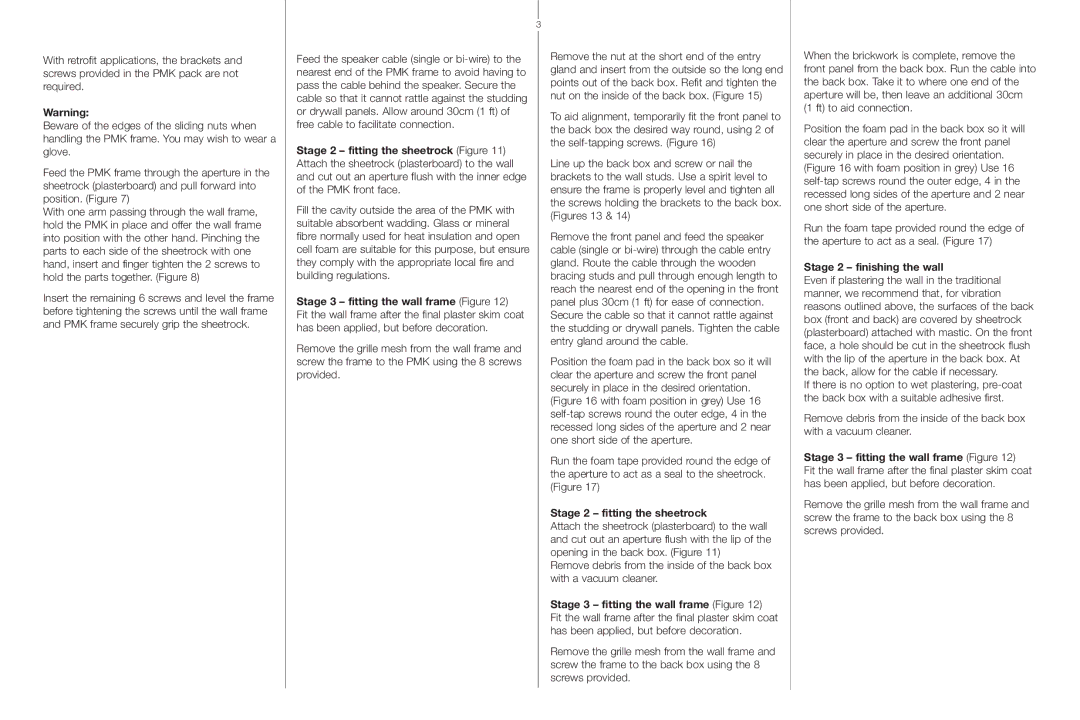3
With retrofit applications, the brackets and screws provided in the PMK pack are not required.
Warning:
Beware of the edges of the sliding nuts when handling the PMK frame. You may wish to wear a glove.
Feed the PMK frame through the aperture in the sheetrock (plasterboard) and pull forward into position. (Figure 7)
With one arm passing through the wall frame, hold the PMK in place and offer the wall frame into position with the other hand. Pinching the parts to each side of the sheetrock with one hand, insert and finger tighten the 2 screws to hold the parts together. (Figure 8)
Insert the remaining 6 screws and level the frame before tightening the screws until the wall frame and PMK frame securely grip the sheetrock.
Feed the speaker cable (single or
Stage 2 – fitting the sheetrock (Figure 11) Attach the sheetrock (plasterboard) to the wall and cut out an aperture flush with the inner edge of the PMK front face.
Fill the cavity outside the area of the PMK with suitable absorbent wadding. Glass or mineral fibre normally used for heat insulation and open cell foam are suitable for this purpose, but ensure they comply with the appropriate local fire and building regulations.
Stage 3 – fitting the wall frame (Figure 12) Fit the wall frame after the final plaster skim coat has been applied, but before decoration.
Remove the grille mesh from the wall frame and screw the frame to the PMK using the 8 screws provided.
Remove the nut at the short end of the entry gland and insert from the outside so the long end points out of the back box. Refit and tighten the nut on the inside of the back box. (Figure 15)
To aid alignment, temporarily fit the front panel to the back box the desired way round, using 2 of the
Line up the back box and screw or nail the brackets to the wall studs. Use a spirit level to ensure the frame is properly level and tighten all the screws holding the brackets to the back box. (Figures 13 & 14)
Remove the front panel and feed the speaker cable (single or
Position the foam pad in the back box so it will clear the aperture and screw the front panel securely in place in the desired orientation. (Figure 16 with foam position in grey) Use 16
Run the foam tape provided round the edge of the aperture to act as a seal to the sheetrock. (Figure 17)
Stage 2 – fitting the sheetrock
Attach the sheetrock (plasterboard) to the wall and cut out an aperture flush with the lip of the opening in the back box. (Figure 11)
Remove debris from the inside of the back box with a vacuum cleaner.
Stage 3 – fitting the wall frame (Figure 12) Fit the wall frame after the final plaster skim coat has been applied, but before decoration.
Remove the grille mesh from the wall frame and screw the frame to the back box using the 8 screws provided.
When the brickwork is complete, remove the front panel from the back box. Run the cable into the back box. Take it to where one end of the aperture will be, then leave an additional 30cm (1 ft) to aid connection.
Position the foam pad in the back box so it will clear the aperture and screw the front panel securely in place in the desired orientation. (Figure 16 with foam position in grey) Use 16
Run the foam tape provided round the edge of the aperture to act as a seal. (Figure 17)
Stage 2 – finishing the wall
Even if plastering the wall in the traditional manner, we recommend that, for vibration reasons outlined above, the surfaces of the back box (front and back) are covered by sheetrock (plasterboard) attached with mastic. On the front face, a hole should be cut in the sheetrock flush with the lip of the aperture in the back box. At the back, allow for the cable if necessary.
If there is no option to wet plastering,
Remove debris from the inside of the back box with a vacuum cleaner.
Stage 3 – fitting the wall frame (Figure 12) Fit the wall frame after the final plaster skim coat has been applied, but before decoration.
Remove the grille mesh from the wall frame and screw the frame to the back box using the 8 screws provided.
